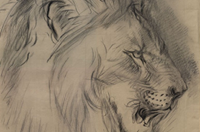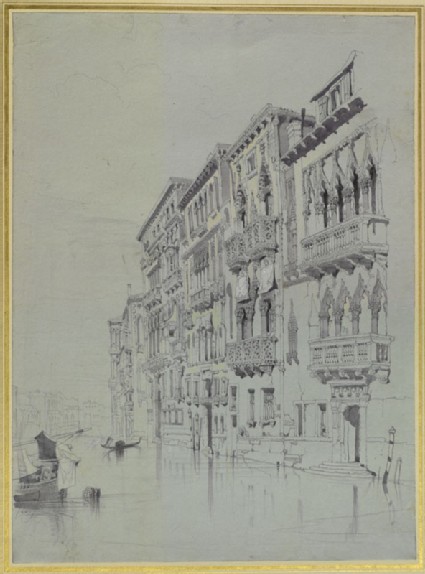Ruskin's Standard & Reference series (1872)
Exemplary works of art. In the catalogue of the Reference series, items marked 'M' are drawings "by my own Hand" (by Ruskin), P are photographs, E engravings and A by Ruskin's Assistant, Arthur Burgess.

Ruskin's Catalogues: 1 object
Show search help- Reference URL
Actions
The Palazzo Contarini-Fasan, Venice John Ruskin
-
Ruskin text
65 Casa Contarini Fasan, Venice. Sketched in 1841 M -
Curator’s description:
Description
The drawing shows a view up the Grand Canal from a point roughly in the middle of the opening into the Bacino di San Marco, focussing on the buildings between the Calle del Traghetto and Rio dele Ostreghe. The buildings are, from right to left: the Palazzo Contarini, with two upper storeys of ogee-arched windows and balconies; the Palazzo Contarini-Fasan, with two upper storeys of ogee arches and very ornate balconies; the Palazzo Manolesso-Ferro, with three upper storeys of round-arched windows; and the Palazzo Flangini-Fini, with two storeys of round-arched windows and an attic storey, and the Rio dele Ostreghe opening into the Grand Canal just beyond it. The Palazzo Pisani-Gritti can just be seen beyond the Rio. One end of a boat, and a small buoy, appear in the bottom left corner, and a gondola just off the Palazzo Flangini-Fini behind them.
Ruskin himself dates the drawing to the period 6-16 May 1841 in "Praeterita" (vol. II, § 56 = XXXV.295-6). It was first catalogued in the Oxford collections in 1872, as no. 64 in the Reference Series, where it accompanied other drawings of architecture in Abbeville, Venice and Verona. The Venetian scenes - many of them early works by Ruskin - were included because they revealed details which could not be seen in photographs, or which had been (or were about to be) destroyed.
In his "Abbeville" catalogue, Ruskin described the drawing as illustrating 'Flamboyant architecture in Venice .... Corrupt. The richness remaining, but the fancy gone. Tracery the only ornament.' (no. 32 = XIX.275.)
Writing in Fors Clavigera on 9 November 1876, Ruskin stated that Prout was so pleased with the drawing that he borrowed it and produced his own drawing from it (now in the Victoria & Albert Museum), which had formed the basis of a popular print (lett. 72, §1 = XXVIII.756; cf. XXIV.xxxv). Certainly, by the time he was compiling "Praeterita", he had decided that 'I can say, now forty years later, with certitude, that they could not have been much better done. I knew absolutely nothing of architecture proper, had never drawn a section nor a leaf moulding; but liked, as Turner did to the end of his days, anything that was graceful and rich, whether Gothic or Renaissance; was entirely certain and delicate in pencil-touch; and drew with an acuteness of delight in the thing as it actually stood, which makes the sketch living and like, from corner to corner. Thus much I could do, and did do, for the last time. Next year I began trying to do what I could not, and have gone on ever since, spending half of my days in that manner.' (vol. II, § 56 = XXXV.295-6.) He had made much the same point, about the pleasure he took in producing these drawings and the lack of pleasure he took in drawing more accurately, in his fifth lecture on the relation of natural science to art, on 22 February 1872 (The Eagle's Nest, § 84 = XXII.183-4). After, all as he noted in his entry on the painting in his 1878 Turner exhibition, 'it would take a month to draw even this small group rightly' (no. 13.R = XIII.500). Elsewhere in the catalogue he noted that 'The exhibition of David Roberts' Syrian sketches put me into a phase of grey washed work with lights of lemon yellow, which lasted till the winter of 1841'; this drawing was one example of 'satisfactory memoranda made at this time' (under no. 24.R.(k) = XIII.507). In an epilogue to "Modern Painters" in 1883, Ruskin wrote how some of the pencil sketches he made at this time 'though full of weaknesses and vulgarities, have also much good in them ... and all of them are of historical interest in their accuracy of representation'; this, and Reference Series no. 64, were two of them (Modern Painters, Epilogue, § 1 = IV.343).
Ruskin called the Palazzo Contarini-Fasan 'the most elaborate piece of architecture in Venice' (Seven Lamps, ch. vi, § 5 = VIII.228); its traceried parapets were directly derived from northern Gothic architecture (Stones of Venice, vol. II, ch. vii, § 18 = X.286). It was 'the richest work of the fifteenth century domestic Gothic in Venice, but notable more for riches than excellence of design', and showed how much 'beauty and dignity' could be given to a plain house by Gothic ornament. Its proportions, criticised by some, were entirely the result of designing a practical and comfortable house in a narrow site (Venetian Index = XI.368-9).
The Palazzo Manolesso-Ferro was, by the 1870s, part of the Grand Hotel, where Ruskin stayed from September 1876 to February 1877 (XXIV.xxxv) - despite considering it 'Fifteenth century Gothic, very hard and bad' (Venetian Index = XI.378). The Palazzo Flangini-Fini was 'Of no importance' (Venetian Index = XI.378).
Ruskin praised the capitals of the Palazzo Pisani-Gritti's first-floor windows, 'singularly spirited and graceful'; the palace itself was 'The latest Venetian Gothic, just passing into Renaissance' (Venetian Index = XI.398).
-
Details
- Artist/maker
-
John Ruskin (1819 - 1900)
- Object type
- drawing
- Material and technique
- graphite, watercolour and bodycolour, with some scratching out, on grey paper
- Dimensions
- 428 x 315 mm
- Associated place
-
- Europe › Italy › Veneto (Venetia) › Venice › Palazzo Pisani-Gritti › Palazzo Pisani-Gritti (subject)
- Europe › Italy › Veneto (Venetia) › Venice › Palazzo Contarini-Fasan › Palazzo Contarini-Fasan (subject)
- Europe › Italy › Veneto (Venetia) › Venice › Ca' Foscari › Ca' Foscari (subject)
- Europe › Italy › Veneto (Venetia) › Venice › Palazzo Contarini del Bovolo › Palazzo Contarini del Bovolo (subject)
- Europe › Italy › Veneto (Venetia) › Venice › Palazzo Flangini-Fini › Palazzo Flangini-Fini (subject)
- Europe › Italy › Veneto (Venetia) › Venice › Palazzo Manolesso-Ferro › Palazzo Manolesso-Ferro (subject)
- Provenance
-
Presented by John Ruskin to the Ruskin Drawing School (University of Oxford), 1875; transferred from the Ruskin Drawing School to the Ashmolean Museum, c.1949.
- No. of items
- 1
- Accession no.
- WA.RS.REF.065
-
Subject terms allocated by curators:
Subjects
-
References in which this object is cited include:
References
Taylor, Gerald, ‘John Ruskin: A Catalogue of Drawings by John Ruskin in the Ashmolean Museum, Oxford’, 7 fascicles, 1998, Oxford, Ashmolean Museum, no. 010
Penny, Nicholas, Ruskin's Drawings, Ashmolean - Christie's Handbooks (London: Phaidon, 1988), no. 2
Ruskin, John, Catalogue of the Reference Series Including Temporarily the First Section of the Standard Series (London: Smith, Elder, [1872]), cat. Reference no. 65
Ruskin, John, ‘Drawings and Photographs, Illustrative of the Art of Verona, Shown at the Royal Institution, Feb. 4th 1870’, Edward T. Cook and Alexander Wedderburn, eds, The Works of John Ruskin: Library Edition, 39 (London: George Allen, 1903-1912), 19, no. 32 = XIX.275
Ruskin, John, ‘The Works of John Ruskin’, Edward T. Cook and Alexander Wedderburn, eds, The Works of John Ruskin: Library Edition, 39 (London: George Allen, 1903-1912), vol. III, pl. 2, f.p. 212
Ruskin, John, ‘The Ruskin Art Collection at Oxford: Catalogues, Notes and Instructions’, Edward T. Cook and Alexander Wedderburn, eds, The Works of John Ruskin: Library Edition, 39 (London: George Allen, 1903-1912), 21, cat. Reference no. 65
Ruskin, John, ‘The Eagle's Nest: Ten Lectures on the Relation of Natural Science to Art, Given Before the University of Oxfored, in Lent Term, 1872’, Edward T. Cook and Alexander Wedderburn, eds, The Works of John Ruskin: Library Edition, 39 (London: George Allen, 1903-1912), 22
Ruskin, John, ‘Fors Clavigera’, Edward T. Cook and Alexander Wedderburn, eds, The Works of John Ruskin: Library Edition, 39 (London: George Allen, 1903-1912), 27-29
Ruskin, John, ‘Modern Painters’, Edward T. Cook and Alexander Wedderburn, eds, The Works of John Ruskin: Library Edition, 39 (London: George Allen, 1903-1912), 3-7
Ruskin, John, ‘Notes By Mr. Ruskin ... on His Drawings by the Late J. M. W. Turner, R. A., [and] on His Own Handiwork Illustrative of Turner’, Edward T. Cook and Alexander Wedderburn, eds, The Works of John Ruskin: Library Edition, 39 (London: George Allen, 1903-1912), 13, no. 13.R = XIII.500; no. 24.R.(k) = XIII.507
Ruskin, John, ‘Praeterita: Outlines of Scenes and Thoughts Perhaps Worthy of Memory in My Past Life’, Edward T. Cook and Alexander Wedderburn, eds, The Works of John Ruskin: Library Edition, 39 (London: George Allen, 1903-1912), 35
Location
-
- Western Art Print Room
Position in Ruskin’s Collection
Ruskin's Catalogues
-
Ruskin's Standard & Reference series (1872)
65 Casa Contarini Fasan, Venice. Sketched in 1841 M






